FRENCH
RIVIERA ROAD TRIP - HUGGING THE COTE D'AZUR
A Road trip through the French Riviera
By Christopher Measom
|
(RICK ARCHER'S NOTE: Mr.
Christopher Meason
wrote this
wonderful story about driving the daring roads of the
Riviera. I would like to share it with you. )
A car journey along the French Riviera is captivating, to say
the least. But it is by no means a road trip in the American
sense of vast distances and devil-may-care parking. No, it's
definitely a Euro experience where credit cards pay tolls,
parking is always an issue, and instead of barking into a
Wendy's drive-through I speak my best French into a speaker at
the gates of a medieval village so the garbled voice at the
other end can lower the barricade and let me in--wherein I
barely avoid scraping up against the excruciatingly narrow
13th-century ramparts and almost tumble down the marble steps
into the cemetery as I back up in a desperate attempt to turn a
sharp corner.
That said, Marc Chagall is in the cemetery at the
edge of the town of St-Paul-de-Vence, and a wild game of
pétanque (Provence's answer to the Italian boccie) is in
progress as my shaky legs take me to the Café de la Place for a
much-needed beer.
I had been invited to Monte Carlo by the legendary Swedish car
manufacturer Saab to test-drive the groovy lime yellow 9-3
convertible with its snappy guidance system--"prepare to make a
slight left"--and over-the-top rain-sensing windshield wipers.
Of course, I was, like, Wow--Monte Carlo! Casinos, James Bond,
talking cars, Cary Grant, Princess Grace...uh, did they say I'd
be driving on twisty roads? Yup. And as my companion, Kevin,
Smith a former race-car driver turned Saab PR maven, whipped
around the umpteenth hairpin turn on the edge of the Palisades
cliffs far, far above the Mediterranean, the little Mario
Cantone in my head blurted out, "I wonder what Princess Grace
would have thought about these cliffs?" Thus began my tour of
the Riviera. The Saab-smooth but white-knuckle drive high above
the crashing sea was actually lots of fun (think Hitchcock's
To
Catch a Thief) and not nearly as scary as the coming-out I did
(will it never end?). This time I told a group of automotive
journalists that on my new car, no matter where I looked or
which secret buttons I pushed, I could not figure out how to
open the hood. Where was Bond when I needed him? They were very
supportive and even told me that my car has front-wheel drive.
Who knew?
But it was after my weekend of convertibles and hairpin curves
when I slowed down to smell the mimosas--so to speak--that I got
to explore the area and found that there are actually two
Rivieras. There is the well-known Riviera, running along the
coast, like Monaco, all sunglasses and Hermès beach towels; and
just to the north between the sea and the foothills of the Alps
is the lesser-known Arrière Pays ("back country"), a mixture of
picturesque "perched villages" and local industry. The walled
villages are literally perched atop hills, and the industry is
of the fun variety, like perfume and pottery. And because the
amazing light and mild climate attracted practically every
well-known artist of the 20th century, the Riviera is dripping
in art. Even better, the legacy of creativity thrives today in
the local culture. It is not only everywhere to appreciate and
to buy, but to create.
Despite my complete lack of auto expertise, the drive was
glorious. And without a car I would have missed both the view
from the road above Villefranche, a town of terra-cotta
buildings and turquoise shutters stuck to a hillside overlooking
the sea, and the fish soup at the restaurant Charlot 1er Roi des
Coquillages in Cagnes-Sur-Mer, where the flaming soufflé Grand
Marnier made even the locals (and the poodles seated next to
them) stop and stare.
As for navigation, the signposts worked well, and if the name of
the town I was looking for disappeared at one traffic circle, it
normally reappeared at the next. If not, I'd stop for
lunch--always a two-hour affair, which worked out perfectly
because (surprise) everything closes from noon to 2 p.m.
Everything. I caught on to the schedule thing quickly, though:
Restaurants typically close on Monday, museums on Tuesday, and
holidays in France are, well, random.
I went no farther that 25 miles in all--creating a
Nike-logo-shaped path starting at the border of Italy, moving
west along the coast, then curving north and east into the back
country. And although that distance could be covered in an hour
with a 9-3 convertible and well-tied kerchief, a long weekend is
better. Even if you only wanted to drive, eat, swim, and stop at
the odd casino, the pace is slower here. Enjoy it.
Monte Carlo is the only city in the principality of Monaco
(after the Vatican, it is the second smallest sovereign state,
with 30,000 people residing in 0.7 square miles). And yes, it's
as rich and glamorous as in the movies. Even getting there from
the regional airport at Nice is spectacular, since most people
fly by helicopter (faster and cheaper than a cab). Ten euros and
a passport get you into the lovely but painfully quiet Casino de
Monte-Carlo, where roulette wheels spin and intense croupiers
preside in every imaginable language. But unless you are 007,
you will not be invited into the Salon Super Privé. Instead,
park yourself outside at the Café de Paris (directly on the
Place du Casino), order a Kir Royale and critique--I mean,
watch--the passersby. Be sure also to duck into the Cathedral of
St. Nicholas, where Princess Grace had her fairy-tale wedding
and where she is now buried. It's in the old town near the
prince's palace.
To start your road trip from Monte Carlo, first drive east to
Menton (on the Italian border) to see the museum that the
prolific artist-filmmaker-writer (and gay boy) Jean Cocteau
created from a 17th-century fortress. From there I suggest
driving back through Monaco along the road they call the Basse
Corniche (N98), keeping the Mediterranean on your left, just to
revel in the sublime Riviera. In Beaulieu-Sur-Mer, tour the
Villa Kérylos, a detailed reproduction of an ancient Greek home.
The Villa Ephrussi-de-Rothschild in nearby St-Jean-Cap-Ferrat
houses a 5,000-piece art collection; the gardens alone merit a
stop. Villefranche-Sur-Mer is the ultimate Riviera town where
some of the sexiest angels in Christendom reside in the St.
Pierre Chapel, Cocteau's homoerotic homage to the patron saint
of fishermen. And although there is a dearth of organized gay
life along the Riviera, the Lounge Beach restaurant at the end
of Villefranche, on a sandyish beach, sports a rainbow flag.
Farther along the coast in Cagnes-Sur-Mer, Renoir's house and
studio are open to the public.
After my drive along the Riviera, passing by its gay-popular
beaches of Eze, Coco, and Castel, then through Nice, I went
inland. Here you can explore the medieval towns, shop, and see
even more incredible 20th-century art. In Vallauris, the "town
of potters," the Romanesque chapel in the ch?teau is adorned
with Picasso's work, while the Magnelli Museum-Ceramics Museum
is devoted to contemporary ceramics from art nouveau to '50s
deco. Grasse is the perfume capital of the world and the
International Perfumery Museum has an excellent collection of
bottles, including fanciful Schiaparellis. Make an appointment
to create your own fragrance. At La Verrerie de Biot you can
watch them making their unique bubbled glass, then buy it.
Matisse's Rosary Chapel, designed brilliantly from the hanging
oil lamp to the confessional, is in the village of Vence. The
attached museum displays his colorful vestments--a unique look
at Matisse as fashion designer.
"My trip ended in one of the most charming villages of the back
country, St. Paul, also know as St-Paul-de-Vence, clearly
touristy but charming. Ask for the Artistes-Artisans-Galeries
brochure from the tourist office and tell them you want to meet
a local artist. Do not miss the Maeght Foundation, a storehouse
of modern art set in a garden of masterpieces. And at the end of
the day, with your car parked safely outside the village away
from those medieval walls, sit at the Café de la Place, have
yourself a glass of wine and a plate of olives, and start
planning your return: next time to paint, to make glassware, or
to create a perfume. Oh la la!
|

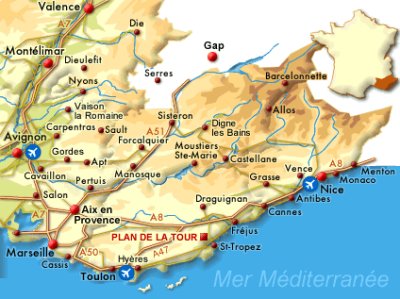
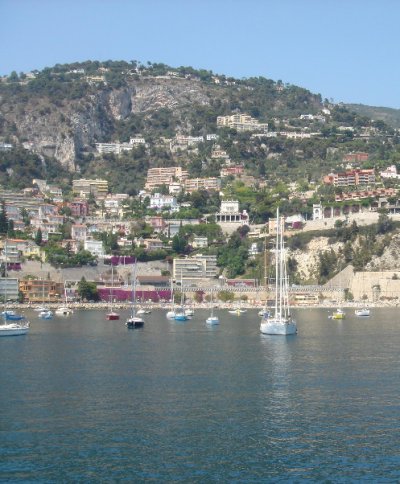
 |
Joie de Vivre on the French Riviera
bY rICK sTEVES
|
(RICK
ARCHER'S NOTE:
Rick Steves
is a prolific writer on everything related to travel.)
I'm in hilly Villefranche-sur-Mer on the French Riviera. It's twilight
and I'm eating at Mere Germaine (Momma Germaine), a restaurant
that got its start feeding hungry GIs in WWII. Germaine's
grandson runs the place today and he's at my table — artfully
filleting six different fish before lovingly ladling on the
broth.
He explains the Riviera's most famous dish to me as if I plan to
cook it back at my hotel: "It's a spicy fish stew based on
recipes handed down from sailors in nearby Marseille. A true
bouillabaisse must contain at least four types of fresh fish —
though we include six. It never has shellfish. We cook the fish
in a tomato-based stock...flavor with saffron and white wine."
He finishes the lesson sprinkling in croutons and capping
everything with a dollop of garlicky rouille sauce.
Savoring perhaps the most expensive dish I've ever eaten in
Europe ($60), I'm engulfed in the Riviera good life. I'm so
close to the harbor I can toss my olive pits into the sea.
Several mega-yachts sit off shore. One's named Lady Maura (I'm
told Maura is an ex-wife of the Saudi King Fahd). You never know
whose stern line you might be catching around here. A skipper
looking formal in his casual wear is shuttled ashore by his tidy
mate in a tiny dinghy...just picking up his statuesque date for
the evening. Germaine's grandson gives me a knowing wink.
Pondering my lavish meal along with the day’s sightseeing, I'm
reminded of the heritage of hedonism unique to this stretch of
Mediterranean beach.
Some of the Riviera's priciest real estate stretches from where
I sit, in Villefranche, to nearby Monaco. Just beyond the Lady
Maura, Cap Ferrat, an extremely exclusive, largely residential
community, fills a peaceful park-like peninsula. While you'll
never get past any gates, I spent a delightful day here just
strolling — and this isn't your average jogging trail. Following
its well-groomed path, I got a glimpse of David Niven's home,
wandered the ritsy port of St. Jean-Cap-Ferrat, toured the
ultimate Riviera mansion and gardens — the Rothschild Ephrussi
Villa, and stumbled upon a hidden little beach. Not very
welcoming, it felt like the private domain of aristocratic
nymphs and satyrs.
In towns all along the Riviera, graceful buildings from the
turn-of-the-last-century line the harborfront — reminders of the
belle époque. It was literally the "beautiful age," when the
world seemed to revolve around the upper class and indulgence
with abandon was a lifestyle.
A prime example of belle époque luxury is the majestic Hôtel
Negresco, overlooking the grand Mediterranean promenade of Nice.
The hotel offers some of the city's most expensive beds and the
chance to step back into that age of extreme refinement. Its
exquisite Royal Salon combines belle époque grace with
engineering by the great French architect Gustav Eiffel. The
chandelier is made of 16,000 pieces of crystal. It was built in
France for the Russian czar's Moscow palace...but, because of
the Bolshevik Revolution, he couldn't take delivery.
Just beyond Nice is the town of Antibes. "Discovered" after WWI,
it enjoyed a particularly roaring '20s — with the help of party
animals such as Rudolf Valentino and the rowdy-yet-very-silent
Charlie Chaplin. They say fun-seekers even invented water skiing
there in the 1920s.
Picasso enjoyed the good life in Antibes. In 1946, 65-year-old
Pablo Picasso was reborn. World War II was over, and Picasso
could finally escape the gray skies and gray uniforms of
Nazi-occupied Paris. Enjoying worldwide fame and the love of
23-year-old Françoise Gilot, he moved to Antibes. He painted
like a madman, spent mornings swimming in the Mediterranean,
evenings partying with friends, and late nights painting again.
Ever-restless, Picasso had finally found his Garden of
Eden...his joy of life. In Antibes' Picasso Museum, his Joie de
Vivre shows the painter's flower-child — Françoise. She kicks up
her heels and dances across a Riviera beach. Flute-playing
satyrs, centaurs, and fauns announce the newfound freedom of a
newly-liberated France and a newly-liberated Picasso.
After decades in the city, Picasso rediscovered the joys of
village life. Shopping at the Antibes market, he'd return home
and turn groceries into masterpieces. With his distinct Cubist
style, he captured sunbathers...and munching locals. He was
fascinated with the simple life of fishermen. Here on the
Riviera, like so many others, Picasso found a pagan paradise,
where civilized people could let their hair down and indulge in
simple, animal pleasures.
Travel, like a bouillabaisse, is the happy result of good things
coming together. For the French Riviera, take a variety of beach
towns, spice with modern art, toss in a pinch of history,
sprinkle in some market fun, and let simmer under the
Mediterranean sun.
|
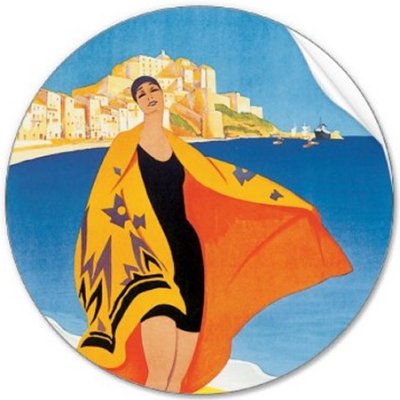
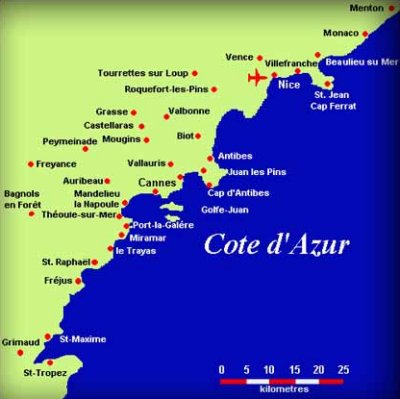
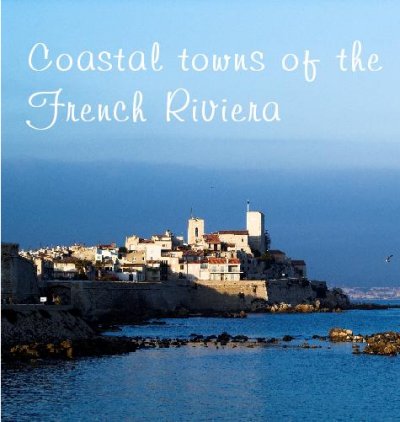 |
HOW I
SPENT MY SUMMER VACATION
By Otto Luck
|
(RICK
ARCHER'S NOTE:
I think this
marvelous story by Otto Luck is a fun read for
anyone traveling to the Riviera. For a change, he writes a
travel story without any intention of selling anything.
As a result, his copy is very entertaining.)
Nice
Nice, our first stop along the French Riviera, is a splendid and
majestic place that easily lives up to its reputation of being
near to heaven on Earth. One might oversimplify it as being sort
of a cross between Paris and Miami Beach. It is far more
laid-back, however, than the former and far less tacky than the
latter.
Nice’s ancient buildings are well-preserved and its seaside
atmosphere is coolly seductive with some of the most pristine
turquoise waters your eyes will ever behold. It’s a fashionable
place where the people are friendly, the streets are bustling,
and the women are exquisite. Even the elderly women are
beautiful here, in a Grand Madame sort of way. How could all
this elegance have come about? The same way the Riviera sky
became so blue, I suppose (i.e., I dunno).
We stayed in two hotels while in Nice. The first was old enough
to include the now obsolete French fixture called the bidét. (If
you’re not familiar with this item, it’s pretty much a cross
between a sink and a toilet bowl, used for the purpose of
cleansing one’s rear end. Needless to say, we opted for the
shower, a modern appliance that actually cleanses the entire
body.)
The second hotel, in which we stayed, was my favorite during our
stay on the Riviera (Hôtel Flots D’Azur, 101 Promenade Des
Anglais). It sits directly on the Côte d’Azur
(the Blue Coast), is moderately priced, includes parking, and is
run by some of the most gracious hosts you’ll find on this side
of the Mediterranean.
One last note, to experience some of the best cafés or get a
taste of the local blues and rock bands, head to Vieux Nice, the
oldest and perhaps most culturally vibrant section of the city.
C’est Cool, as they might say in these parts.
Monaco/Monte Carlo
Our next stop on the map was Monaco. Put simply, this place is
just not my cup of thé. My wife (the illustrious Pumpkin Luck)
says this is because I lost at the tables. Be this as it may,
Monaco still appears to be a stiff autocratic province whose
main attractions include parading you past Princess Grace’s
grave, draining you of your money at the Monte Carlo casinos
(see above), and showing you a 35-minute clip of the country’s
barbaric history at 38 francs a pop.
The area is swarming with cops. Rumor has it that surveillance
cameras sit in every crevice and cubbyhole recording your every
move. Monaco, in fact, appears to be all about well-protected
wealth and little else. Sadly, you’ll find the same profile of
visitor in the gaming rooms as you would in the environs of
Atlantic City (not the spirits of James Bond, Cary Grant and
Marlene Deitrich and company).
The country is still ruled by a monarchy, a similar lot to those
who were overthrown eons ago in the French Revolution. The best
thing I can say about Monaco is that the ride to it from Nice is
nothing short of outstanding, with gorgeous mountain views and
clear shots of the aqua-blue water at every breathtaking curve
of the winding coastal road. Unfortunately, what follows upon
arrival is a bit of a let down, if your taste is anywhere in
line with mine.
Vence
Drove in from the coast, after a couple of days, to the hillside
village of Vence. Honestly, I don’t know if I have the
imagination or skill to describe the beauty of this place. It’s
as if one of the most idyllic portraits of the French
countryside has somehow sprung to life and we’ve had the good
fortune to magically step into it. Here in Vence it appears as
if a simpler, more enchanting era has been frozen in time.
Small stone buildings predate the existence of anything called
America. They dot the mountainside, with their terra cotta roofs
and shuttered windows, masterfully built into the sloping
terrain. Down below, narrow streets wind through the village in
no meaningful direction but somehow lead to one remarkable and
historic place after another.
Woke up in the morning with the sun beating through the casement
window of our hotel room, and the sounds of French children
playing in the street. The village bell was striking nine. It
was like a scene from the Twilight Zone, the one where the
careworn city dweller blinks his eyes and somehow finds himself
in the most pastoral setting imaginable.
Concerning the hotel, our host was somewhat short on manners
(and somewhat short on towels) so, I can’t, in good conscious,
recommend the accommodations. Vence, itself, however, is as
magnificent as they come.
Cannes
On the last leg of our journey we traveled to the cities of
Cannes and Saint-Tropez. I suppose the optimal phrase to
describe these places is Jet Set. Ancient buildings house
elegant shops that sell top-of-line clothing and jewelry: Hermés,
Cartier, Dior, et al.
The people, too, are elegant -- as one would expect. The men
appear to be the sophisticated European types relaxing between
jaunts to the two or three Mediterranean islands they own. The
women are slender, fashionable things whose clothing appears to
be painted on as flawlessly as their makeup.
A funny thing about the beaches at Cannes, though, they were
inhabited with an older population, one in which I would guess
the average age to be somewhere around 127, give or take a year.
At night, however, the restaurants attract a younger, more
vibrant crowd. The small alley of St. Antoine, in particular,
houses a fashionable group who wine and dine through all hours
of the evening.
The Beach at Saint-Tropez
Saint-Tropez, also lives up to its reputation as haunt for
globe-trotters. Our visit was cursory, at best, so I can only
supply limited information. I will say that the Saint-Tropez
beaches are far more private and chic than those we experienced
at Cannes. They are a bit tougher to access, however, being a
few kilometers from the town’s center, but this probably
accounts for the fact that they remain so beautiful and
exclusive, so the extra effort to reach them is clearly worth
it.
|
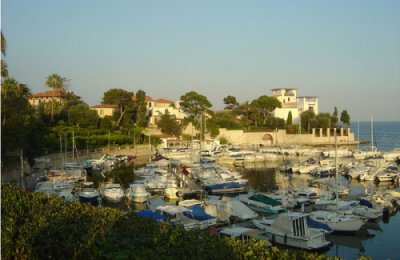
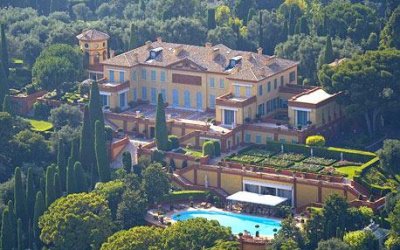


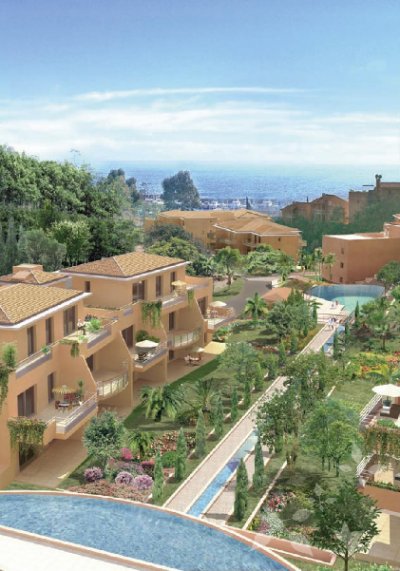 |
THE BEACHES OF
THE FRENCH RIVIERA
|
With their worldwide fame as the earth's most glamorous beaches,
the real thing often comes as a shock to first-timers: much of
the Côte d'Azur is lined with rock and pebble, and the beaches
are narrow swaths backed by city streets or roaring highways.
Only St-Tropez, Cannes, and isolated bits around Fréjus and
Antibes have sandy waterfronts, hence their legendary
popularity. Many beaches are privately operated, renting
parasols and mattresses to anyone who pays; if you're a guest at
one of the local hotels, you'll get a discount. Fees for private
beaches average EUR 6-EUR 10 for a dressing room and mattress,
between EUR 2 and EUR 4 for a parasol, and between EUR 4 and EUR
5 for a cabana to call your own. Private beaches alternate with
open stretches of public frontage.
St-Tropez
The best plages (beaches) are scattered along a 5-km (3-mi)
stretch reached by the Route des Plages (Beach Road); the most
fashionable are Moorea and Club 55; the most daring is the
mostly topless Tahiti. Those beaches close to town—Plage des
Greniers and the Bouillabaisse —are accessible on foot, but many
prefer the 10-km (6-mi) sandy crescent at Les Salins and the
long, sandy stretch of the Plage de Pampelonne, 4 km (3 mi) from
town. Bicycles are an ideal way to get to the beach, and Espace
83 is a popular place for rentals. Holiday Bikes offers a wide variety of bikes for hire.
Ste-Maxime
You may be put off by the heavily built-up waterfront bristling
with parking-garage-style apartments and hotels, and its
position directly on the waterfront highway, but Ste-Maxime is
an affordable family resort with fine sandy beaches. It even has
a sliver of car-free Vieille Ville and a stand of majestic plane
trees sheltering central place Victor-Hugo. The main beach,
north of town, is the wide and sandy La Nartelle.
Cannes
Most of the beaches along La Croisette are owned by hotels
and/or restaurants, though this doesn't necessarily mean the
hotels or restaurants front the beach. It does mean they own a
patch of beachfront bearing their name, where they rent out
chaise longues, mats, and umbrellas to the public and hotel
guests (who also have to pay). Public beaches are between the
color-coordinated private beach umbrellas and offer simple open
showers and basic toilets. Sailboats can be rented at either
port or with some of the beachfront hotels.
Antibes
Antibes and Juan together claim 25 km (15½ mi) of coastline and
48 beaches (including Cap d'Antibes). In Antibes you can choose
between small sandy inlets—such as La Gravette, below the port;
the central place de Ponteil; and Plage de la Salis, toward the
Cap—rocky escarpments around the Vieille Ville; or the vast
stretch of sand above the Fort Carré.
Juan-les-Pins
If Antibes is the elderly, historic parent, then Juan-les-Pins
is the jazzy younger-sister resort town that, with Antibes,
bracelets the wrist of the Cap d'Antibes. The scene along Juan's
waterfront is something to behold, with thousands of
international sunseekers flowing up and down the promenade or
lying flank to flank on its endless stretch of sand. The Plage
de Juan-les-Pins is made up of sand, not pebbles, and ranks
among the Riviera's best (rent a beach chair from the nearby
hotel concessions, the best of which is Les Belles Rives).
Nice
Nice's beaches extend all along the Baie des Anges, backed
full-length by the Promenade des Anglais. Public stretches
alternate with posh private beaches that have restaurants—and
bar service, mattresses and parasols, waterskiing, parasailing,
windsurfing, and jet-skiing. One of the handiest private beaches
is the Beau Rivage, set across from the Opera.
The sun can also be yours for the basking at Ruhl, across from the casino.
|
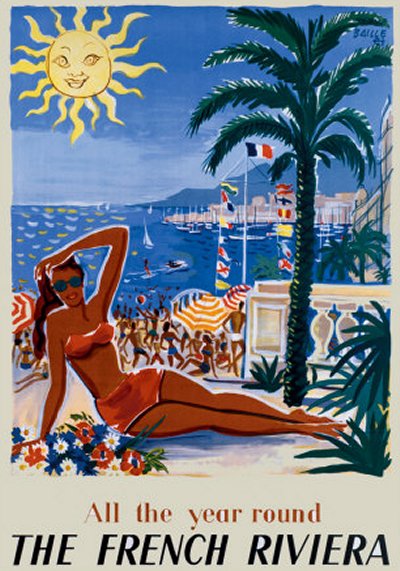
 |
 |
THE TOPLESS
TEN, UH...
THE TOP TEN REASONS TO GO TO THE FRENCH RIVIERA
|
Eastern Riviera
Monaco, toy kingdom: Yes, Virginia, you can afford to visit
Monte Carlo—that is, if you avoid its casinos and head instead
for its magnificent tropical gardens.
Picasso & Company: Because artists have long loved the Côte
d'Azur, it is blessed with superb art museums, including the
Fondation Maeght in St-Paul and the Musée Picasso in Antibes.
Èze, island in the sky: The most perfectly perched of the
coast's villages perchés, Èze has some of the most breathtaking
views this isde of a NASA space capsule.
Nice, Queen of the Riviera: With its bonbon-colored palaces,
blue Baie des Anges, time-stained Old Town, and Musée Matisse,
this is one of France's most colorful cities.
Sunkissed Cap d'Antibes: Bordering well-hidden mansions and
zillion-dollar hotels, the Sentier Tirepoil is a spectacular
footpath along the sea.
Western Riviera
St-Tropez à go-go: Brave the world's most outlandish fishing
port in high summer and soak up the scene. Just don't forget the
fake-tan lotion.
Les Gorges du Verdon: Peer down into its vertiginous green
depths and you'll understand why this is one of the most
dramatic natural sites in France.
Picture-perfect Moustiers-Ste-Marie: Best known for its faïence,
this town is also worth visiting for the sight of houses
clinging to the cliffs—often with entrances on different levels.
A gothic château extravaganza: In Mandelieu-La Napoule, discover
the most bizarrely extravagant house of the coast—the Château de
la Napoule, festooned with tapestries, peacocks, and art
students.
Beguiling Cotignac: With almost no boutiques but a lively weekly
market, this is a place to experience Provençal life in the slow
lane.And one
more reason - the most beautiful women in the world come
here...
|

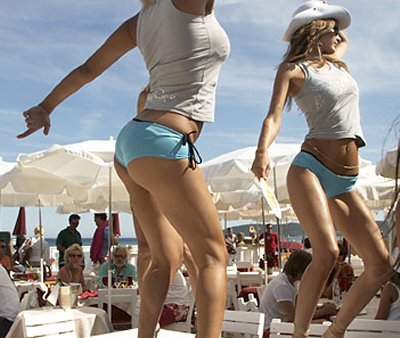 |
THE FRENCH
RIVIERA TRAVEL GUIDE -
FODOR
|
The French Riviera, also known as the Riviera, is synonymous
with the sea, golden beaches and, above all, a lot of luxury.
But this place coastal France has much more to offer, as its
cultural and artistic inexhaustible. In fact, for legendary
artists like Picasso, Renoir and Matisse, this beautiful
environment was a great source of inspiration for his life and
his most famous works.
In the course of seventy miles of coast between Menton and
Cannes, the French Riviera stretches, located in neighboring
France. This region contains picturesque cities, which include
Cannes, Cagnes Sur Mer, Nice and Menton. The Riviera has become
a much sought after tourist destination since it started to mass
tourism in the last decade of the fifties. Previously, it was an
inhospitable coast, but since the nineteenth century began to be
visited in winter by aristocrats from cold regions abroad. At
present, the luxury is felt in its extensive waterfront, in
their palms, their expensive hotels and large yachts.
However, the French Riviera also has beautiful natural
landscapes, divided between its beaches, mountains and valleys.
But what is striking in a special way is the cultural richness
that this coastal location offers. Contemporary artists such as
Picasso, Renoir, Matisse and Léger, have left this place in his
artistic legacy, so that each of these famous people here have
their own museum. This is the case of a museum reporting in
Cagnes Sur Mer, the National Picasso Museum in Vallauris, Henri
Matisse Museum in Nice and the Jean Cocteau Museum in Menton. It
should know that art lovers can buy the card Musées Côte d’Azur,
which allows a free and unlimited access to endless queues of
permanent collections and temporary exhibitions of 65 museums
and monuments.
As a natural destination, the Riviera shows seventy kilometers
of golden beach, with a mild climate that allows you to enjoy a
warm atmosphere throughout the year. The coast has a promenade
that goes practically from Cannes to Menton and the beautiful
palm trees that come in its entirety. Beaches, public and
private, are paradise and one of the main reasons for visiting
the Riviera. Highlights of the Midi, Cannes and Nice are obliged
to visit the beaches of pebbles, in the Paseo de Anglais. In the
city of Nice is the park of Mercantour, where marmots and
chamois can be seen between the waterfalls and streams and
mountain peaks of over three thousand meters.
Moreover, the Riviera is famous for its fine dining and recipes
savory dishes of the restaurants reach very high scores on the
culinary guides from different countries. Recommended dishes
include fish stew with garlic, fish soup or lamb. They are also
the delicious niçoise salad, made with onions, anchovies, rice
and tomatoes, and pissaladière, a Provencal tart made of tuna,
capers and anchovies.
Cannes and Nice
Two highly sought destinations within the region of the Riviera
are Cannes and Nice. The city of Cannes is world famous for its
international film festival, but has many other attractions: its
beaches, its trendy clubs and its hospitable people. The major
points of interest are the rue Meynadier, cosmopolitan
atmosphere of a street, Le Palais des Festivals and the
Croisette. One can also visit the Church of Du Bon Voyage, of
the eighteenth century, Alexander III and St. Georges. They are
also recommended to visit the flower market and fruits, park and
garden Roseraie Alexandre III. On the other hand, from Cannes
can be reached by boat, three islands that are fascinating:
Lérins, a quiet island, Santa Margarita, historic place where he
was imprisoned the legendary man of the Iron Mask and the beach
of San Honorato, a impressive Gothic monastery.
Another of the major cities of the Costa Azul is Nice. It’s
cultural and leisure activities is endless. Places full of charm
are the palace of the prefecture, the Opera, in the nineteenth
century, Mediterranée casino, the castle in the hills of Mount
Boron and Modern outdoor theater. In the hills above Nice Cimiez
district, this is preserved from Roman times as a place of
residence for the powerful. Characters known as Matisse, among
others, lived in this rich neighborhood. Currently, its economy
has declined and is inhabited by less affluent and commercial
premises. There are museums dedicated to Matisse and Chagall,
the Roman ruins and some springs of the second century.
With the Alps playing bodyguard against inland winds and the
sultry Mediterranean warming the breezes, the Côte d'Azur, or
French Riviera, is pampered by a nearly tropical climate. This
is where the dreamland of azure waters and indigo sky begins,
where balustraded white villas edge the blue horizon, evening
air is perfumed with jasmine and mimosa, and parasol pines
silhouette against sunsets of ripe apricot and gold. As
emblematic as the sheet-music cover for a Jazz Age tune, the
Côte d'Azur seems to epitomize happiness, a state of being the
world pursues with a vengeance.
But the Jazz Age dream confronts modern reality: on the hills
that undulate along the blue water, every cliff, cranny, gully,
and plain bristles with cubes of hot-pink cement and iron
balconies, each skewed to catch a glimpse of the sea and the
sun. Like a rosy rash, these crawl and spread, outnumbering the
trees and blocking each other's views. Their owners and renters,
who arrive on every vacation and at every holiday—Easter,
Christmas, Carnival, All Saints' Day—choke the tiered highways
with bumper-to-bumper cars, and on a hot day in high summer the
traffic to the beach—slow-flowing at any time—coagulates and
blisters in the sun.
There has always been a rush to the Côte d'Azur (or Azure
Coast), starting with the ancient Greeks, who were drawn
eastward from Marseille to market their goods to the natives.
From the 18th-century English aristocrats who claimed it as one
vast spa to the 19th-century Russian nobles who transformed Nice
into a tropical St. Petersburg to the 20th-century American
tycoons who cast themselves as romantic sheiks, the beckoning
coast became a blank slate for their whims.
Like the modern
vacationers who followed, they all left their mark—villas,
shrines—temples all to the sensual pleasures of the sun and
sultry sea breezes. Artists, too, made the Côte d'Azur their
own, as museum goers who have studied the sunny legacy of
Picasso, Renoir, Matisse, and Chagall will attest. Today's
admirers can take this all in, along with the Riviera's textbook
points of interest: animated St-Tropez; the Belle Epoque aura of
Cannes; the towns made famous by Picasso—Antibes, Vallauris,
Mougins; the urban charms of Nice; and several spots where the
per-capita population of billionaires must be among the highest
on the planet: Cap d'Antibes, Villefranche-sur-Mer, and Monaco.
Veterans know that the beauty of the Côte d'Azur coastline is
only skin deep, a thin veneer of coddled glamour that hugs the
water and hides a much more ascetic region up in the hills.
These low-lying mountains and deep gorges are known as the
arrière-pays (backcountry) for good cause: they are as aloof and
isolated as the waterfront resorts are in the swim.
Medieval
stone villages cap rocky hills and play out scenes of Provençal
life—the game of boules, the slowly savored pastis (the
anise-and-licorice-flavored spirit mixed slowly with water), the
farmers' market—as if the ocean were a hundred miles away. Some
of them have become virtual Provençal theme parks, catering to
busloads of tourists day-tripping from the coast. But just
behind them, dozens of hill towns stand virtually untouched, and
you can lose yourself in a cobblestone maze.
You could drive from St-Tropez to the border of Italy in three
hours and take in the entire Riviera, so small is this renowned
stretch of Mediterranean coast. Along the way you'll undoubtedly
encounter the downside: jammed beaches, insolent waiters serving
frozen seafood, traffic gridlock. But once you dabble your feet
off the docks in a picturesque port full of brightly painted
boats, or drink a Lillet in a hilltop village high above the
coast, or tip your face up to the sun from a boardwalk park
bench and doze off to the rhythm of the waves, you will very
likely be seduced to linger.
|
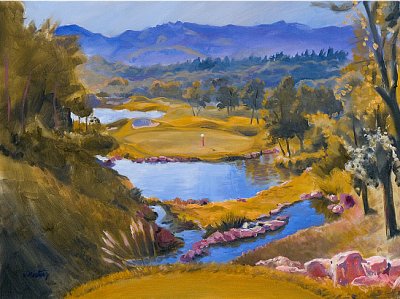
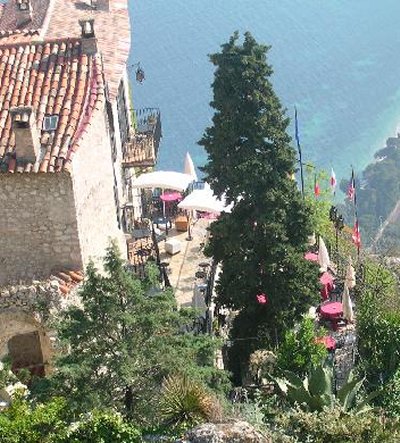
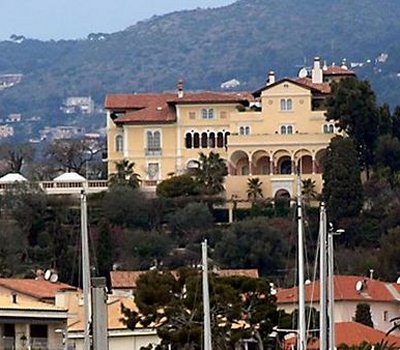

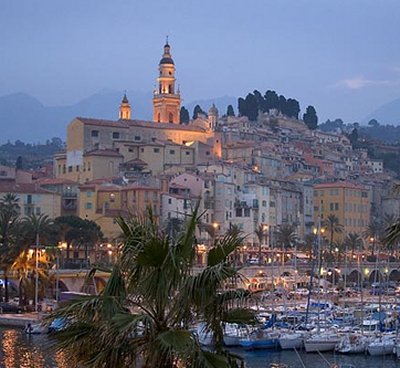 |
THE MANY FACES
OF THE FRENCH RIVIERA
By Walter and Cherie Glaser
|
(RICK ARCHER'S NOTE:
I think this
is a fascinating story about the
French Riviera.
Walter and Cherie Glaser have written my absolute favorite
travelogue.)
The French Riviera -- the very name conjures up visions of
movie starlets stepping out of sports Mercedes, of shapely
young women tanning topless on the beach, of elegant couples
in dinner suits and evening gowns sitting at the Black Jack
tables of small, stylish casinos, of multi-million-dollar
megayachts tied up at glamorous marinas, and of holidaying
crowds wandering along the Promenade des Anglais, the famous
waterfront street of Nice. And all these images would be
correct, for the Riviera can be all things to all people --
a dream destination where anything can happen (remember the
movie Dirty Rotten Scoundrels?) and any wish come true.
But unfortunately many people visit the Riviera without
knowing where to go and what to see, often missing out on
some of the best and most fascinating aspects of this
many-faceted jewel. Perhaps, then, you may wish to come with
us and explore the more interesting and sometimes out of the
way places that draw us back to the Riviera year after year.
A word of advice here. Avoid July and August when planning
your trip. Not only is the weather a little too hot for
comfort, but the whole of Europe seems to descend on the
Riviera in those months, pushing down the standard of
service, and sending prices rocketing. Insiders visit the
Riviera in May and June or September and October. At that
time the wall to wall crowds are still ... or already ...
absent, the weather is balmy, and you don't need to queue up
for restaurants. You can enjoy what is to many Europe's
finest watering hole, without having crowds from France and
what seems to be every tourist from Germany, Belgium,
Holland, Switzerland, Britain, Scandinavia, Asia, America,
Australia and more lately Eastern Europe breathing right
down your neck.
As long as you don't linger too long in Nice, it's a good
place to start. After all it's the major airport for the
Riviera and international airlines are now starting to fly
in also. There is no shortage of good hotels, and which you
choose will depend on your budget as much as on your taste.
Stroll slowly along the Promenade des Anglais. This must be
the world's best place for people-watching. If you are from
the America or the Asia/Pacific region, and are used to
golden-sand beaches that stretch for miles, you will be
amazed how stony and comparatively uninviting the beach at
Nice is. The backpackers and masochists seem to be happy
enough to ignore this and spread towels out over the large
pebbles. The hedonists and those prepared to spend the cash,
luxuriate in the deck chairs provided on the wooden
platforms that offer "pay as you tan" comfort.
Should the little white tourist train come past, hail it and
take the trip. Yes, it's touristy and perhaps a little kitch,
but it does point out the interesting spots in Nice, and its
the sort of thing that's fun once and madness twice!
On a day when you are wearing your Sunday best, stop as you
reach the red-domed Hotel Negresco, (Promenade des Anglais) and look inside. This is arguably the most
stylish and most elegant hotel on the Riviera. Look at the Chantecler Restaurant, perhaps making a mental note to dine
there for a most romantic ... but not inexpensive ...dinner.
There is also a less expensive restaurant, based on the
theme of a fairground carousel that most would also greatly
enjoy.
Even if your budget does not allow you to stay or dine at
this splendid hotel, look inside. The chandelier was ordered
by the Tsar of Russia for his St. Petersburg Palace, but he
was murdered before it was completed. That chandelier, made
by the famous Baccarat Company was bought by the Negresco
for The Salon Royale, to hang under the glass dome which was
designed by Gustave Eiffel of Tower fame.
And if you are a male, and have your pocket camera handy,
you may just want to photograph the mens' toilet downstairs.
No! I'm not drunk or kidding when I suggest this. You may
have seen some unusual washrooms in your life, but I promise
you one that is quite remarkable here. The theme is
Napoleonic, with half-helmets used as reflectors for the
wall lights, and officers campaign trunks that open to
reveal washbasins. I don't quite know the significance of
the battlescene mural that rises above the urinals, but the
whole effect is nothing if not brilliantly dramatic.
Naturally, the other public rooms of the Negresco are less
controversial, but they are equally original and truly
splendid.
The Avenue Jean Medecin in Nice is another "must do" place,
although I've never really found it all that exciting. It
does, however, have some lovely shops and some excellent
outdoor restaurants where dining is a lot of fun.
Shopping in Nice is fairly simple. One option is to start at
the Place Massena and go down the main shopping street. Most
people make their first stop the Galeries Lafayette, the
biggest department store in town. They often have a 10%
discount for tourists, but you must ask for this. Also
remember that, if you spend more than 2,000 francs, you are
entitled to shop and get your VAT ... value added tax ...
refunded when you leave. Ask the English-speaking enquiry
girl for details.
Don't miss the new Marks and Spencer store further along the
street. Here M and S fans will find exactly the same range
as in London at only a very marginally higher price. And I
have a special tip for wine buffs. If you want to present
any of your French friends with American, Australian,
Chilean, South African or New Zealand wine, and show them
how good these can be, you will not only find them in the
food department of M and S, but at a price that is probably
no dearer than these wines are in their countries of origin.
And as for M and S clothing, many consider this the best
value for money merchandise of its kind anywhere. And the
street is full of temptations with names like Bally and many
others well represented.
An historic and poignant touch is the Russian Orthodox
Cathedral at 17 Blvd. du Tzarewitch just off Gambetta Blvd.
The son of Tsar Nicholas had tuberculosis and was sent to
Nice by the last Tsar in the hope that the young man would
recover. When he died, instead the Russian Orthodox Chapel
and Church were built here in the shape of the colourful
onion-domed churches of Moscow fame. The other splendid
attraction in Nice I would recommend is the Chagall Museum
in Rue du Docteur Menard. This has some splendid works by
this brilliant artist and is well worth a visit.
Culture vultures will also not want to miss the Musee
Matisse, 164 Avenue des Arenes-de-Cimiez,
which features some of that artist's outstanding works.
Alongside is the Musee Archeologique, with some brilliant
exhibits of what life was like in the small ... population
20,000 ... Roman town of Cimiez, the predecessor of Nice,
2,000 years ago.
If you have stayed in Nice to this point, you have not
needed a car. But to explore the rest of the Riviera, a
self-drive car is virtually essential. And here's another
tip. If you are coming from another country, you may get a
very much better deal if you pre-book your vehicle with your
local Hertz office or another large rental agency. Hertz is
well represented on the Riviera and you won't need a large
expensive car, especially with gasoline being two to three
times the price you may pay in North America.
Those for whom budgets are not all that tight have a real
treat in store for them. They will be the lucky ones who can
enjoy what are some of the finest hotels in Europe. These
... with the exception of the aforementioned Negresco ...
are out of Nice, but relatively close on what is, in my
opinion, Europe's best road system. Here are some hotels
that are the stuff dreams are made of. With the elegance
demanded by the aristocracy for which they were built, the
sheer class with which they have been maintained, a standard
of impeccable service that has to be experienced to be
believed and a cuisine which is a pacesetter for the world,
the hotels of the Riviera I will tell you about here are a
hard act to follow. Why stay there? Because they are
possibly the world's best in their class. Sure, they're not
for everybody. But they are built for those who can afford
the very best and, as one retired American executive said to
me, "There are no pockets in shrouds. And we're having the
holiday of a lifetime here. My grandchildren don't know it,
but they're paying for our holiday. When we die they'll just
get that much less."
The hotels which fall into this class are the Hotel de
Paris, Monaco; The Hotels Royal Riviera and La Reserve in
Beaulieu-Sur-Mer, The Grand Hotel du Cap Ferrat at Cap
Ferrat, The Hotel Saint Martin (Route de Coursegoules Vence) at Vence and The Hotel Byblos (Route de
Coursegoules Vence) at Saint Tropez. Added
to these must come two fascinating hotels that are part of
the ramparts of 13th Century hill villages, the Hostellerie
Chevre d'Or at Eze Village, and the Hotel Saint Paul in the
artists' village of Saint Paul de Vence. All of these are at
the top of their class, but more about this later.
Right now we'll start at the point closest to the Italian
border, La Turbie and Peillon, just past Monaco and some
thirty minutes from Nice by high-speed freeway on the high
Corniche. There are three roads that take you to the Italian
border from Nice. The low Corniche is the coast road that
follows the sea, the middle Corniche is just atop the cliffs
that rise vertically just inside the shore line and the high
Corniche is further inland, and a breathtaking work of
engineering of the sort for which both the French and the
Swiss are justifiably famous. But few know that the original
Grand Corniche was the Roman Via Aurelia, along which Roman
Legions marched from Rome to the Rhone Valley and on to
their outposts in Britain and Germany. In 1806 Napoleon
built the first proper road that followed this path, but
with breathtaking engineering and viaducts, the modern
autoroute you travel on to Italy makes the journey
incredibly easy.
Most people don't use the exit to La Turbie, but it is worth
the effort, for in this charming village you will find one
of Rome's grandest monuments, La Trophee des Alpes. This
huge Roman monument was built by Emperor Augustus five years
B.C. -- a 150 foot high monument on 120 foot square base
that commemorates the subjugation of the 44 Ligurian tribes
that had, till then, been a thorn in the side of the Romans,
disrupting traffic between Rome and Gaul. The monument was,
in fact, erected on the spot that marks the border between
Rome and that province. It is one of the most imposing Roman
monuments in existence, and well worth the visit.
Within a two hour hike across wooded mountains lie two
medival villages. Peillon and Peillie are as yet almost
totally unspoilt by tourism, their inhabitants making a
livelihood from the cultivation of age-old olive groves that
cover the hillsides. By car the trip from La Turbie is quite
a roundabout one, but do take it! These villages have to be
seen to be believed and are absolutely charming.
Back in the car, carefully wind your way down the zigzag
road that leads to the lower village. Yes! You are right.
That is the one that, according to locals, Grace Kelly (oops
-- Princess Grace of Monaco) was killed on. But while care
must still be taken, the road has been very substantially
improved and is not the hazard it used to be.
If you want to stay in the make-believe world of Monte
Carlo, then the best place to choose is doubtlessly the
Hotel de Paris right alongside the Casino. Once you've seen this hotel, it
will come as no surprise to you when I tell you that it
belongs to a company owned by the Grimaldis, the family of
Prince Rainier. There's only one standard here, and that's
perfection. The suites are almost solidly booked the year
round, and when you look down from the windows at Monte
Carlo's lovely, horseshoe-shaped harbour-marina, one can see
the guests' mega-yachts, some with their own helicopters on
top, at their moorings. I suppose one gets some indication
of the clientele from the fact that, when we were there just
recently, seven Rolls Royces were parked outside the front
entrance.
And if you have come to France for a special celebration, a
great place to have this is in the almost unbelievably
splendid dining room: Restaurant Louis XV. Those who have
always fantasised about being invited to dine at a Royal
Palace don't need to use their imagination after dining
here. This room is at least as elegant. And the cuisine is
of a standard to match. There are only twenty chefs in the
whole of France who have been awarded three Michelin stars,
and Alain Ducasse is one of them. In a country where the
dinner table conversation is as passionate when people talk
about cuisine as when they talk about politics or sex,
Ducasse is considered a national hero -- a Matisse of the
kitchen whose palette of flavors can paint culinary
canvasses of perfect taste and balance.
There is not a whole lot to do in Monaco, but it is a
marvelous base for exploring the area. Before this,
however, don't forget to wander around the marina and drool
over some of the magnificent boats you will see there. Take
your time exploring the Oceanographic Museum, considered by
experts the best of its kind in the world. Play a round of
golf at the Monte Carlo Golf Club. The concierge will
arrange it. Visit the two large Casinos -- perhaps you too
can become "The Person who Broke the Bank at Monte Carlo."
Before you leave, ask the Concierge at your hotel what
special events are on in town. The tax-exiles who make up
most of the population here pride themselves on being
culture vultures, and so Monte Carlo has an extraordinary
number of world standard concerts, operas, performers and so
on. And that's not all. When we were there recently, the
Italian Army had sent a special regiment from Genoa that was
quite remarkable. This regiment's history dates back to the
time when both Genoa and the whole coast to Nice belonged to
Savoy. So, for ceremonial occasions, this regiment dresses
in absolutely authentic uniforms that date back to the times
of the Prince of Savoy. And here they were in Monaco,
marching through the side streets and, complete with a
stirring band, precision marching in the square in front of
the Monaco Palace. Marvelous!!! There is also the famous
cactus garden, but we'll pass this up for another for which
we will head as soon as we leave Monaco.
And to do this we head out, taking the new tunnel and
following the signs up to Eze Village. In the 13th century,
Saracen pirates had a rather clear run of the Mediterranean
and some of them decided to stay, building a whole lot of
fortified villages which the French now call "Village Perche"
because these are built in such a way that they look as if
they are glued on to the side, or on the top of, cliffs or
mountain tops in the most precarious, but most easily
defensible position.
By and large these villages were taken over by locals when
the Saracens went home to North Africa, but after a while
the locals found they were a bit hard to get to, so one
after another they were abandoned. It was not until the
1920's, when technology allowed water to be pumped to these
villages and roads to be built that they were re-settled.
Today they are picture-post-card pretty, many full of
delightful galleries of painters, sculptors and artisans
who, along with smart boutiques, have made these villages
'res chic. The upper village of Eze is one of these.
Stop in the car-park, wander up the steep walking track into
this beautifully restored village, and drool over the superb
handicrafts and other knicknackery on sale in the Eze shops.
Go right up to the top and visit the cactus garden which, to
my mind, is even lovelier ... especially if you are an
Indian Fakir ... than the one at Monte Carlo. When you have
done all this, stroll back down to the Hostellerie Chevre
d'Or, one of the two rustic hotels that I find so charming
on this coast.
Go into the Chevre d'Or and
have a drink on the terrace. This is undoubtedly one of the
loveliest views in the world ...as long as you don't suffer
from vertigo... To sit next to one of the two pools, look
vertically down at the coast and cars that look like ants
running along the coastal road, is one of life's great
pleasures. It was here at Eze that Nietzsche wrote Thus
spoke Zarathustra , and the late Walt Disney arrived for a
two day holiday and liked it so much that he stayed two
weeks. If your budget allows, linger here a day or two. If
not, dine in the splendid dining room. And if you've spent
too much money on your holiday already, then ask at the desk
for their other less grand restaurants which are under the
direction of the same top-notch chef and management.
Once down on the coast road at Lower Eze, drive towards Nice
until you come to the pretty coastal village of
Beaulieu-Sur-Mer. This is where you will find two of the
other luxury hotels that, to my mind, make up the coast's
most stylish establishments, the Royal Riviera and La
Reserve. When Gordon Bennett, the eccentric owner of the New
York Herald who sent Stanley to look for Livingstone, built
La Reserve in the 1870's, he was so enamored with it that
word spread fast about what he considered the finest hotel
on the Cote d' Azur. Much of the current excellence of this
hotel, and the adjacent Royal Riviera which is of equally
high standard, is due to the personal supervision of Mr.
Gilbert Irondelle, the former Resident Manager of Hong
Kong's prestigious Mandarin Hotel. Irondelle's philosophy is
simple -- settle for nothing less than the very best. And it
shows. Whether you stay at the smaller La Reserve ... around
40 rooms ... or at the slightly larger Royal Riviera of
around 70 rooms, you will be treated as if you were an
aristocratic house guest. Both hotels face the
Mediterranean, and both are as romantic as they are
luxurious.
At Beaulieu-Sur-Mer you will also find one of the most
attractive small marinas on the Cote d'Azur. Wander among
the boats and dream about the destinations marked on their
sterns. Lunch at one of the many restaurants that line the
harbourside. For years we were regulars at the African Queen
but more recently this restaurant has been most
disappointing and we have switched to Le Madrepore next door
which we find excellent.
If you like a small, intimate and quite elegant Casino, the
one at Beaulieu is back in business, beautifully restored
after being closed for several years following a succession
of armed hold-ups that quite put the fashionable clientele
off their Roulette. Take your passport and wear your best
outfit. You won't get in without the former, and if you look
the slightest bit disreputable your chances of entry also
drop to zero.
Another "must do" at Beaulieu is to visit the Villa Kerylos.
This amazing re-production of a 5th B.C. Athenian's home is
authentic right down to the furnishings and the garden. It
was built in 1908 by archeologist Theodore Reinach who,
through his training, knew exactly how to decorate the villa
in the style of 2,500 years ago. Only the modern wiring,
plumbing, window glass and concealed piano were allowed to
impinge on the original style.
Within walking distance of Beaulieu is Cap Ferrat, and no
other piece of earth is more densely populated with famous
people. Eiffel of Tower fame retired to Beaulieu. Charlie
Chaplin came to Cap Ferrat each year for his holidays, as
did the late Duke Connaught. Famous author Somerset Maugham
lived and wrote his books here until his death in 1965. King
Leopold II of the Belgians retired here as did David Niven
and several of the Rothschilds. One branch of this family,
banker Baron Ephrussi who had married Beatrice de Rothschild
built an Italianate villa that features a Tiopoto ceiling,
paintings by Doucher and a covered Andalusian patio which
was used in many movies (Dirty Rotten Scoundrels was filmed
in this area, as were several James Bond movies). The
Ephrussis left their villa to the French State in their will
and it has now become one of the coast's best museums.
Almost at the tip of the Cap Ferrat Peninsula is another
superb hotel -- the Grand Hotel Cap Ferrat. This is another one on my list of luxury
gems. It would be hard to imagine a more stylish setting
than this hotel set in huge grounds and with its own four-seater
cable railway that takes guests down to the swimming pool
and bistro by the sea! The Grand Hotel Cap Ferrat is a
definite inclusion in the Riviera's best and those who come
to the area should at least dine at its elegant restaurant.
There is lots more exploring to do before you leave the
Riviera. In Part 2 we will explore Venice, and the artists'
village of St. Paul, the third biggest tourist attraction in
France after Paris and Mont St. Michel. Take the
unbelievable drive along the Gorges du Loup, Gourdon and
Tourette Sur Loup. Visit the picturesque village of Mougins
where superchef Roger Verge rules supreme, and visit the
Escoffier Museum at Villeneuve-Loubet. Take the coast road
past France's biggest apartment block to stop at Antibes,
Cannes and stop at the charming little bay of La Garoupe at
Cap d'Antibes, where few foreigners are found, then go on to
picture-postcard St. Tropez.
All these are great places you should also see, but that's
another story!
|
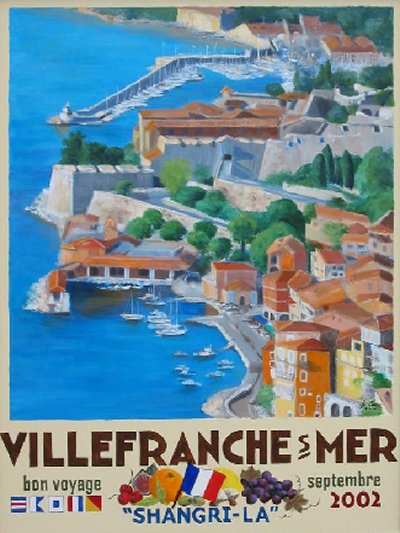
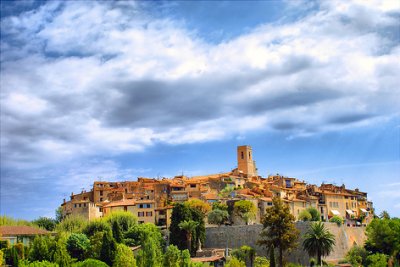
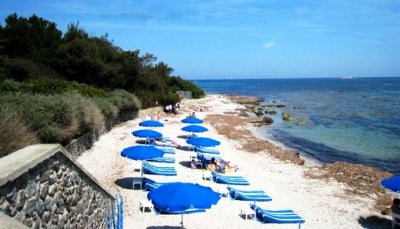
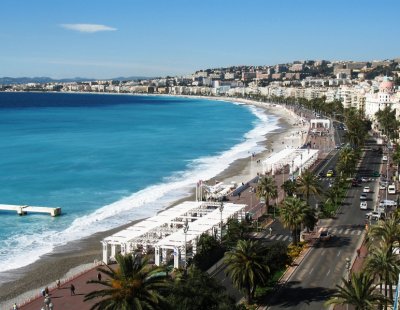
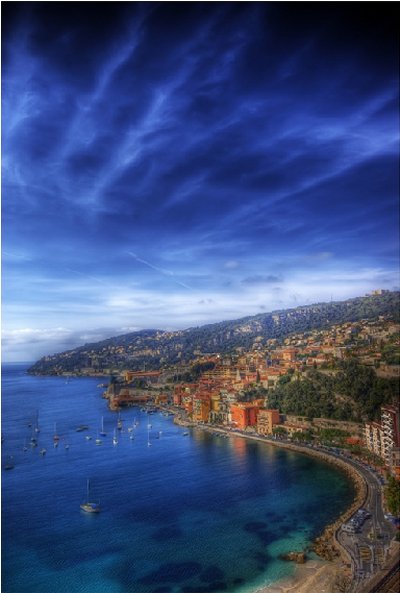
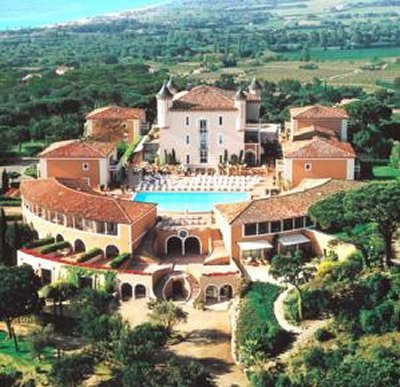
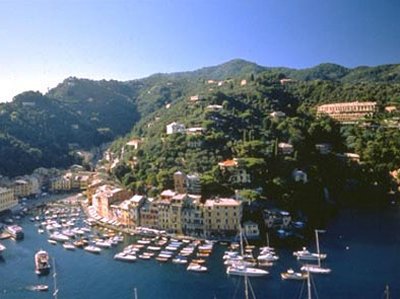
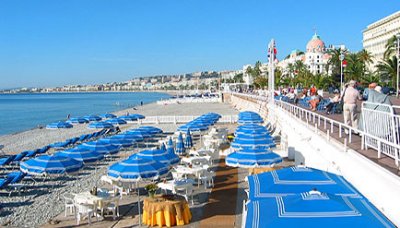
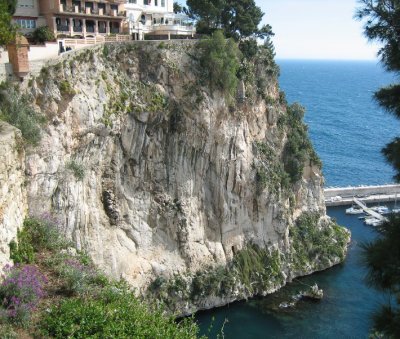

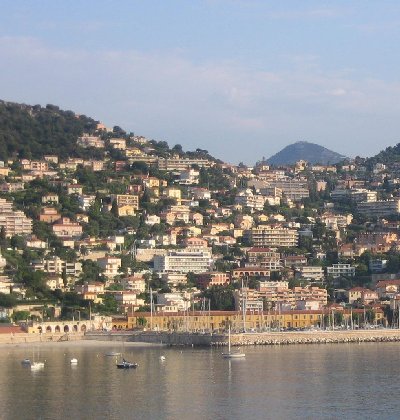
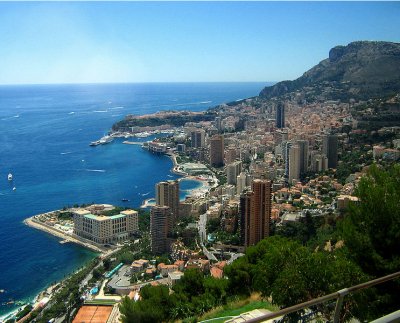 |
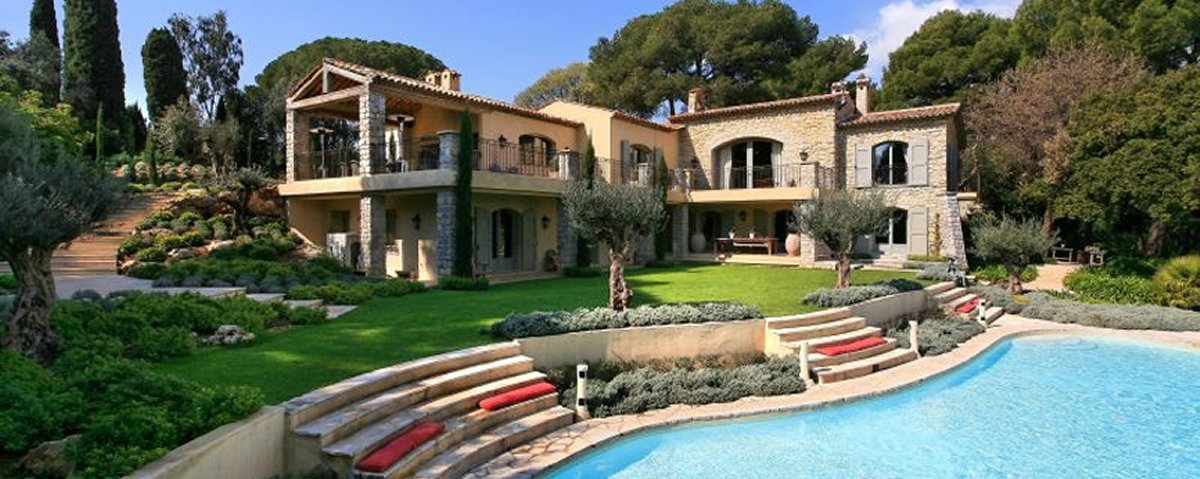 |
|